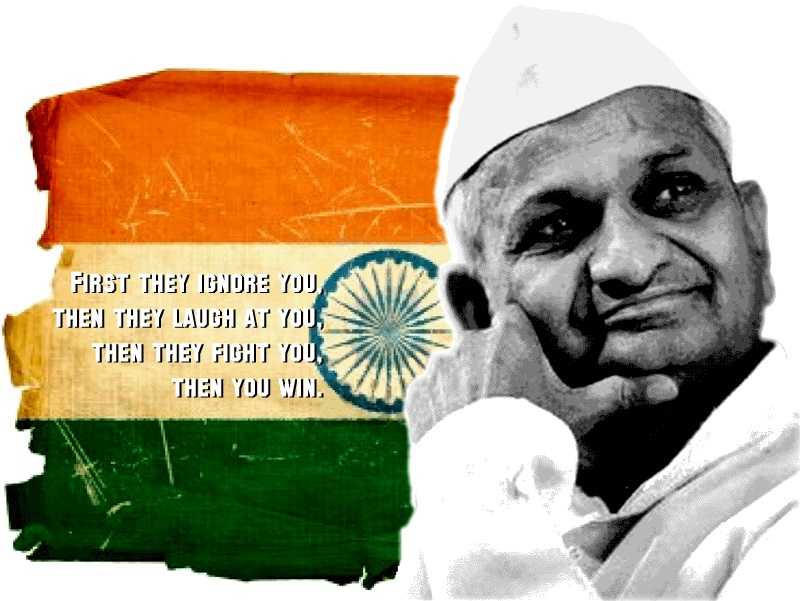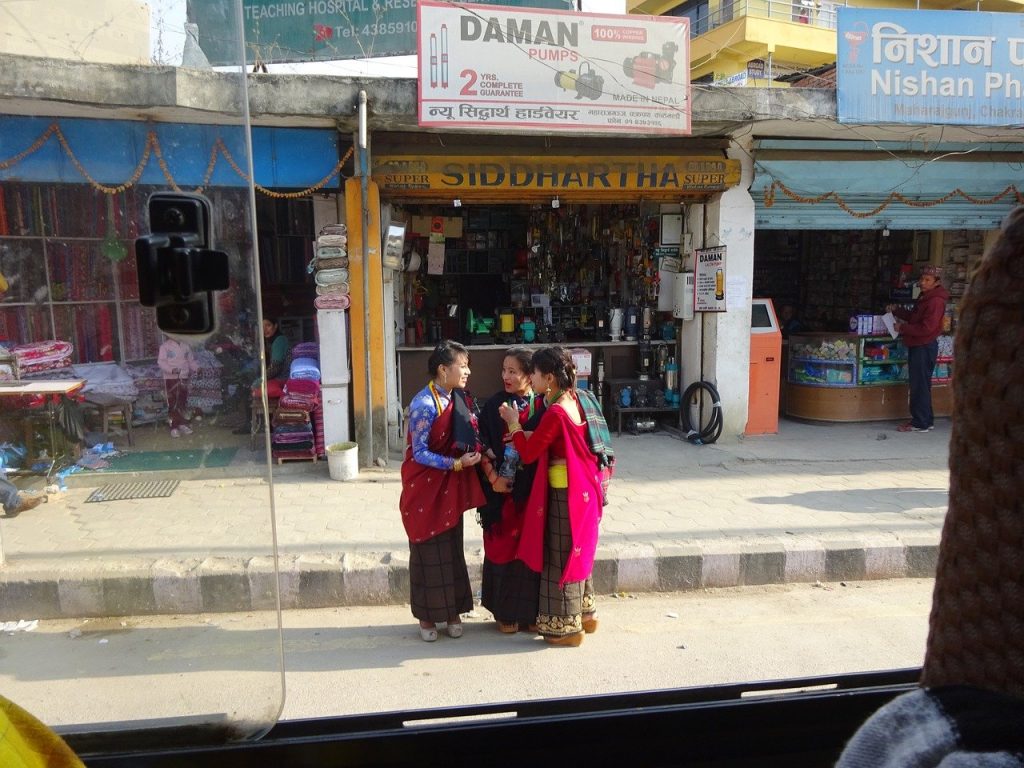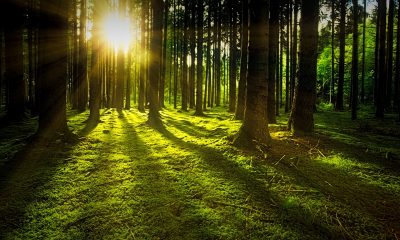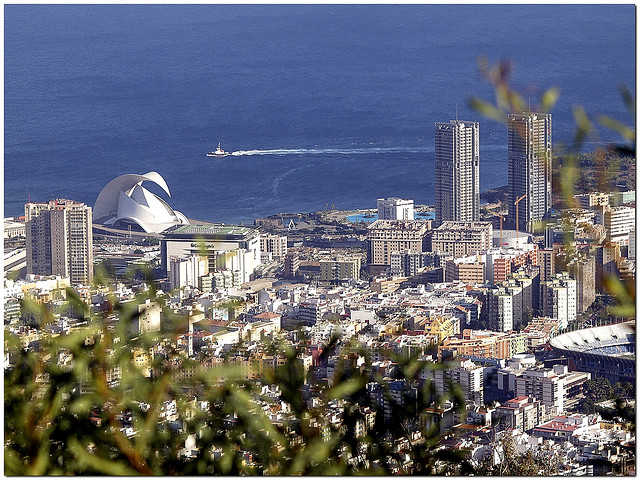India
Is Anna another Gandhi? Should such labels matter for a national campaign?
Even as Anna recovered from health issues, his criticism from detractors and worship by followers shows no signs of abatement. Given that the government sympathizers are hell-bent on proving that Anna is no Gandhi, it is important to ask if there are parallels between Anna and Gandhi. More important than the comparison between the two heroes, is to ask, if it really matters whether Anna is Gandhi. Most importantly, we need to worry if we are too focused on personalities rather than on issues.
The anticorruption campaign spearheaded by Anna has had a rather forceful yet ridiculous slogan “Anna nahi ye aandhi hai, yahi desh ke Gandhi hai”. Ridiculous it certainly was but no more ridiculous than the slogans of many other social and political campaigns, including the most transformational ones. More than ridiculous, this slogan was an effective one. In a nation full of gods, demigods, saints and mahatmas it is not a surprise that Anna Hazare, a great hero, was compared to the sacred cow image of Gandhi and a lot of colorful slogans were used in the campaign. It was an effort to raise the stature of one very effective human hero, a person of his time, with great leadership qualities and many failings, to the level of the godly image of another exceptional leader of his time. Just as Gandhi stood up to the need of the hour so did Anna in galvanizing support for a mass movement. Given that Indian public is always ready to drink the kool aid of sainthood and personal vilification, Anna’s detractors have been busy proving that one undemocratic mere-mortal Anna Hazare is not comparable to their great savior Mahatma.

The main claim is that Mohandas Karamchand Gandhi believed in heart transformation of his opponents, while Hazare wants his enemies to conform. Let us examine the claim. Gandhi, at times, successfully forced British to conform, instead of changing their hearts but enough has been written on those achievements of his, so for a change, I would give you some less than favorable examples of the conduct of father of Indian nation. A look at forcing Subhas Chandra Bose to quit the position of president of Congress when Gandhi could not get his candidate elected can be an eye opener for anyone wanting to see Gandhi’s willingness to twist and bend his opponents will instead of relying on heart transformation and democratic means. Gandhi’s differences with Tagore are often hyped but Gandhi’s reluctance to budge in that equation is again not hidden from any student of modern Indian history. It was not with heart conversion that Gandhi forced a secular, socialist, non-violent champion of unity of South Asia – Khan Abdul Ghaffar Khan, the red shirt alliance leader of Pathans, to accept the dictates of Jinnah’s partition plan. Ghaffar Khan, a lifelong Gandhian appropriately wrote of the betrayal and complained of throwing the fate of Pathans to the hounds of separatism exploiting religion. By no means, I am putting the sole or even an overwhelming burden of partition on the shoulders of Gandhi but I am trying to make it clear that it was not just those who should be considered opponents of the Indian independence but also even those who championed the cause of India, who were forced to conform by Gandhi. I would also urge readers to realize that for many differences between Gandhi and Subhas or Gandhi and Tagore, one should not see their interaction in just black and white of antagonism but in the shades of grey that also involved tremendous corporation. So the charge on Anna, forcing an irresponsible and dictatorial government to budge through non-Gandhian means is untrue, not because Anna is not sticking to heart transformation alone but because even Gandhi did not. In fact, Anna has been less stubborn than Gandhi and Gandhi would have acted no different than Anna in a similar situation.
Just as the association with Gandhi gave some people credibility so does the association with Anna. In fact, now all of the politicians in opposition are attracted to Anna as are bees to the nectar. Similar to Gandhi, Anna has a handpicked team, some with genuine mass support and some without a base. While the charge of non-elected representatives trying to voice Indian concerns is somewhat (not completely) true but for all the pretense of our founding fathers being answerable to people, a look at the electoral play of Congress and Muslim League for much of 30s and 40s will make one realize that it is a repeat of historical mistakes but not a deviation from the sorry existing pattern of South Asian politics. I realize that my last point is an aside, as I am talking of people who run the show on name of a credible leader, instead of the leaders themselves, so it is not a valid comparison of the two people: Hazare and Gandhi but I am just trying to draw historical parallels. Back to Hazare and Gandhi, Anna has been criticized for his lack of inclusiveness. It is somewhat true. He has taken support of progressive forces simply for granted but bent over backwards to allow sectarian Mullahs and Sanghis to share his dais just to make the movement look like a rainbow coalition. This top down approach of getting communities involved by bringing in his fold their leaders has been a plague of all Indian struggles. Such short cut has in part been a reflection of an immature culture of putting too much faith in some leaders by the followers and treatment of followers by the leaders as some kind of sheep herds. Gandhi’s lack of sufficient inclusiveness and acceptance of progressive, freethinking and modern elements, apart from a token self-proclaimed modernist Nehru, who was preoccupied with pushing other agendas of personal ambition more than modernist causes, is similar in this campaign too.
Both Anna and Gandhi have not been secular in true sense of the word. Instead of keeping religion at bay they both have used the Indian logic of balancing different religions. This spirit is unfortunately even summarized in Indian constitution as “sarvadharma sambhava”, which translates to equal respect for all religions instead of secularism: a clear separation of religion and state. Gandhi, a devout Vaishnav, was in part responsible for turning Muslims away from a Congress that transformed under his leadership from a secular but elitist organization into a rural Hindu spiritual organization with mass following. There is no denial that this transformation also catalyzed mass enrollment that otherwise would have taken a longer and harder road of enlightenment and education leading to a modern, progressive and all encompassing struggle. This pro-Hindu bias of Gandhi was not just present during the early change of character of congress that in part sowed the seeds of partition but there are also instances of Gandhi turning his back on Muslims during communal strife, especially at the time of British and even Hindu reaction to the atrocities of Mopla rebellion. No, I am not justifying the heinous dimensions of Mopla rebellion that involved killing of non-Muslims but I am talking of Gandhi’s response to it. Apart from Hindu appeasement, Gandhi was equally responsible for Muslim appeasement at the cost of Hindus interests at multiple times. Inclusion of the Khailafat movement that demanded respectable treatment of the remnants of the Ottoman Empire, instead of being concerned with the fate of poor Indians at the forefront of anti-British coalition during the First World War ended up encouraging separate Muslim and Hindu identities instead of promoting a united Indian identity. It consolidated the schism between two non-concentric circles of faith tearing the Muslim identity in the subcontinent: one centered on South Asia: ones motherland and other centered in the foreign Turk and Arab lands associated with mythologies and religion. One can only regret a lack of secular approach that would have excluded all religious demands – Hindu or Muslim from contaminating Indian interests. This compromise of yielding to the backward Muslim feudal religious identity that was more concerned with the fate of Turks than Indians during World War one was not the only compromise of Gandhi. Who can forget Gandhi giving Jinnah the legitimacy of becoming the Quaid, capable of speaking on behalf of whole Muslim quom? In total, Gandhi may not have leaned more to Hindus or more to Muslims, if viewed in totality but in this case the average or the sum total of his leanings hides more than it reveals. Instead of having no business with either faith or having equal disdain for the stupidity of faith based politics, Gandhi tried to balance his biases and leanings. Just as Gandhi dealt with leaders as representatives of Hindu or Muslim community instead of bottom up approach of building true mass base everywhere, when confronted with challenge of inclusion of separatist forces, Anna has not taken a much different road either. Anna is willing to court Hindu and Muslim fundamentalists and religious leaders alike, just as Gandhi did. Anna, like Gandhi is not a secularist or progressive in the modern sense of the word. Who can forget the well-orchestrated publicity stunt of children of underprivileged caste and of Muslim faith helping break Anna’s fast to provide a photo finish to the fast?
In his village, Anna acts like a patriarch, a benevolent dictator who knows what is best for everyone. Anna like Gandhi believes himself to be on some kind of God ordained mission where instead of skeptical secular questioning to evolve solutions, he clearly knows what is right and what is wrong based on his faith. Apart from the obvious weakness in the nature of campaigns due to inclusion of people with religious fundamentalist and separatist interests and overall damage to Indian subcontinent due to backward religious thinking there have been some positive dimensions due to this contamination of religion in mass movements too. Given their unwavering religious faith, both Gandhi and Anna have put all their personal life aside for the sake of what they consider right and necessary sacrifice for their country. The spiritual leader facet of both the leaders has also resulted in them being regarded as a miracle cure to problems by the wide-eyed public. This provides for instant galvanization of support that through secular, educated and questioning means would require longer struggles. Both men did not show any problems being minted as saints. This embrace of sainthood can only come from either religious conviction in ones “right path” or sham performance to grab power. Neither Gandhi nor Anna are in the struggle for iota of personal benefit so clearly this embrace of sainthood comes from their religious convictions.
In his private life Anna has in fact been more of a Gandhi than Gandhi could ever be. Both humans, with obvious failings have within the human bounds bravely experimented with the nature of what they consider ‘truth’. Anna never married, tried addictions, visited prostitute, and verbally and physically assaulted his immediate family member to embrace his way of life, at least nothing comparable to the path of metamorphosis of saint of Sabarmati into a Mahatma. In public life, imposition of ones way of life by Gandhi and Anna has been undeniable. So one should note that though justifiable personal vilification of Anna is easily possible but it is more difficult than that of Gandhi.
Many accusations of Anna not being Gandhi have come from explicit and implicit charge that Anna is not sticking to the principles of non-violence. There is a need to address the question of the use of non-violence as matter of principle or pragmatic policy. One needs to ask where such approach is more successful than others. Indian experiment has been an amazing example of the demonstration of both the pragmatic as well as moral strength and weakness of non-violence. I think examples of success of non-violence such as in salt march and of utter failures as in the inability to prevent Churchill from causing genocide of over 5 million East Indians during the Bengal famine is relevant for a detailed discussion elsewhere. Let us discuss here if Anna is deviating significantly from Gandhi in the use of violence. Just as Gandhi faltered at times in containing the anger of masses so has Anna. Did Gandhi condone violence more than Hazare by considering Bhagwat Gita, a call for arms for sake of ones duty, as his spiritual guide in comparison to Anna’s mere statement on a slap to Sharad Pawar by an angry citizen? Minor deviations aside, up till now Anna has been more successful than Gandhi was in containing people’s anger from spilling over and turning violent. Given that people read what they want to read, for the record, I would also like to state clearly that by defending Anna’s non-violence, in this article I am not defending, condemning or condoning the possibly destructive and violent potential of the wide eyed angry crowd.
I hope that I have shown you the stark similarities between Anna and Gandhi, sufficient to respond to the unjustified criticism of Anna not being Gandhi. I also hope that you realize the need of the comparison of the two is equally as silly as is the criticism. The reason that this comparison of the two is silly and very sad is because it shows how Indians needs justification of one person to be legitimate leader only if one can be connected to a higher unquestionable image, instead of being a questionable human hero. Unfortunately one needs sacred cows, just as Gandhi needed to be minted into a saint, for him to have a mass appeal. It reflects how majority is not willing to support and oppose something in an issue-based manner. How is it different than acceptance of Nehru Gandhi Royalty with dodgy citizenship credentials, unaccounted assets, criminal records and false educational degrees, as having a special place in Indian politics?
I hope that you will admire and criticize Anna whether he can be compared to Gandhi or not in your eyes. Anna being Anna has done a great job and should be credited for it. He has also failed at many instances. When Indian population starts questioning and caring, more Hazares and Gandhis would spring from our soil every day than have sprung in centuries of struggle, because it is everyone in the Indian youth who has the transformational potential and not some specially ordained ones to carry the tricolor to glory at the world stage.
India
Government Changing Syllabus to Include Sikh History in India

Chief Minister of Uttar Pradesh, most populous state in India, has announced inclusion of Sikh history in the state syllabus. Students of all schools under UP State Board will see the new chapters. The announcement came when Chief Minister Yogi Adityanath (BJP) was observing Sahibzada Diwas.
Why do we Observe Sahibzada Diwas?
Sahibzada Diwas marks the martyrdom of four ‘sahibzada’ (or sons) of Guru Gobind Singh (10th Sikh Guru) and his mother Mata Gujri. In the year 1705, Mughal Emperor Aurangzeb had ordered torturing of youngest sons of Guru Gobind Singh aged 5 and 8. He later executed the little sons by burying them alive into a wall. The reason for this act was that they refused to convert to Islam. Soon after this event Guru Gobind Singh’s mother, Mata Gujri also martyred her life under Aurangzeb’s captivity. The cause of her death is still unclear. Guru Gobind Singh’s other two sons martyred their life in the Battle of Chamkaur Sahib. Thus the 10th Sikh Guru, Guru Gobind Singh had lost his whole family by 27th December. This is an important event in the Sikh history in India and UP Government is finally keen on observing Sahibzada Diwas every year.
Why UP Government is Changing the Syllabus?
Soon after the independence of India in 1947, the school education came under tight grip of far left and communists. Most of the Indian history in the recent past has been written by Romila Thapar and Irfan Habib. They have close ties with left wing ideology and Irfan Habib has delcared himself as Marxist. They wrote history text books by either phasing out sections of Indian history or diluting certain events. The motivation to soft alter the history has been to propagate left-wing/communist ideology. Historian Koenraad Elst once highlighted that Romila Thapar is comfortable neither in Sanskrit nor in Farsi language. The knowledge of these two languages is a must to understand India’s history.
In the recent years, various public opinions have gained momentum to rewrite Indian text books to include more content on Indian rulers and native ideas. Currently, Indian text books mainly teaches about foreign rulers of India such as Mughals and British.
With this announcement of inclusion of Sikh history in history text books, the government is bringing historical facts in mainstream.
27th December as Real Children’s Day
Chief Minister Yogi Adityanath has also reached out to the Education Minister to declare Sahibzada Diwas as Children’s day. He further added that “The history of Sikh gurus will be a part of the syllabus. Apart from this, we should observe December 27 every year as Sahibzada Diwas in all schools. Today is the day to pay gratitude to the sons of the Guru and mother who martyred their lives for the motherland, country and religion.” Yogi Adityanath also said that “No society can move ahead if it forgets history. The Sikh society is known for its hard work. The Sikh gurus sacrificed their lives to defend the Hindu religion. The country will always remember this.”
Yogi Adityanath added that learning about the sacrifices by Sikh Gurus would inspire future generations to dedicate themselves into nation-building. He emphasized that we should make future generations realize that India and Indian culture was safe because of sacrifices of Sikhs.
What Should We Do On Sahibzada Diwas?
Sahibzada Diwas should be an important day for every Indian regardless of their region, culture or religion. On this day, we are in the Holiday mood as it falls right between Christmas and New Year’s eve. However, we should remember that a Guru and his entire family sacrificed their life for the well being of India and the idea of India.
On this day we can fast, do sewa (service), visit a nearby Gurudwara and sleep on the floor at night.
China
Nepal Hindu Rashtra: Time to Wrap Up Communism?

Nepal abolished the Constitutional Monarchy in May 2008 and declared itself as a Federal Democratic Republic. There was a new hope in Nepal as it was becoming world’s newest democracy even though it had dissolved the Hindu Rashtra. However, the democracy in Nepal immediately got into the tight grips of leftists and communists backed by China. It has been almost 12 years since monarchy was abolished in Nepal. Interestingly, the Himalayan country has already seen 11 Prime Ministers in this period. Thus, leaving the Nepalese people still yearning for good and stable governance.
Re-establish Hindu Rashtra
As the political instability is growing in Nepal, people are demonstrating concerns about the future of the country. In fact, Nepalese citizens are unhappy with frequent interference by China and India influencing its unstable communist regime. More voices are now growing in support of reinstating the Monarchy and declaring Nepal as world’s only Hindu Rashtra (which by default offers full religious freedom to other religious minorities as per Hindutva concept of Sarva Dharma Sama Bhava – all paths lead to one).
Former Deputy Prime Minister of Nepal, Kamal Thapa said that if political parties do not recognize the seriousness of reinstating the monarchy, then the country will head for a period of darkness. “Recently, we’ve had high-ranking officials from India and China come to Nepal to try and solve problems within the ruling party,” he said. “We cannot let others dictate what we want to do.”
Communist Party All Set to Suppress Protests, By Force
Kamal Thapa has firmly demanded an all party meet to discuss reinstating of monarchy. Throughout the month of December, 2020 Nepal has seen anti communism protests across the country in support of reinstating the monarchy and Hindu Rashtra. Most importantly, the demand has become a nationwide mass people’s movement. So much so that the communist regime had to send a directive to 77 districts in 7 provinces. The directive suggests suppressing the protests by force. Nevertheless, Rashtriya Prajatantra Party and other royalist groups have ignored this threat from the communist regime. Protester groups have pledged to strengthen the protest in the coming weeks.
Nepal: Demonstration held in capital Kathmandu, demanding restoration of monarchy in the country. pic.twitter.com/TFjmKu9U9Z
— ANI (@ANI) December 5, 2020
Role of China – Hope for Communism in Nepal
China’s ambassador to Nepal is known to have very close relationship with Nepalese Communist regime. In fact, She has been super effective in tilting Nepal’s posture towards its ideological partner, China. One of her greatest achievements in 2020 was artificially manufacturing a border conflict between Nepal and India. Consequently, souring relations between the two Hindu majority nations. In addition, she managed to silence Nepal’s communist government after China took one of Nepal’s border villages under its control. However, recent political turmoil in Nepal and a renewed demand for reinstating of Hindu Monarchy is showing that the situation is now out of Chinese hands
Role of India
Year 2020, was not a good year for India and Nepal relations. India was busy in controlling domestic Covid cases. On the other hand, China had launched an invasive campaign into Indian territory. In addition, India is always busy with Pakistan on its western borders. However, the surprise came to India when China was almost successful in creating a new border tension between India and Nepal.
Those who do not know about Indian government should note that the current ruling party in India finds itself ideologically opposite to communism. This further creates differences between the two countries.
Communist party in Nepal has blamed India for supporting the ongoing anti communism protests in Nepal. However, former advisor to Nepal’s PM has suggested there is no proof that India is fueling pro Monarchy, anti communism demand in Nepal.
Nevertheless, There are certain influencers in India who have, in their personal capacity, expressed support for reinstating the Hindu monarchy. Yogi Adityanath, who is the Chief Minister of an Indian state bordering Nepal, said in 2015 that Nepal should declare itself a Hindu Monarchy. Readers should note that in 2015 Yogi Adityanath was not the Chief Minister yet. However, today he is not only popular in south of Nepal, his popularity is growing in Nepal as well.
Will The World See the first Hindu Rashtra?
It is difficult to answer this question at this moment. However, Nepalese communist government could not resolve the political instability and in December 2020 Nepalese government dissolved the parliament. Nepal will see next elections in April – May 2021. Hopefully, the world will see Nepal’s 12th Prime Minister in 13 years or may be a Hindu King? Royalists and protester groups have expressed confidence in winning next elections. We have our eyes on Nepal for updates.
India
Humanity Endures During Coronavirus Pandemic

Photo by Press Information Bureau, Government of India
The world changed exponentially since the pandemic broke out. We changed too. Emotions are running high. We have learnt to take one day at a time and have stopped expecting changes to happen overnight.
“COVID19 is menacing the whole of humanity – and so the whole of humanity must fight back”
A clarion call from United Nations Secretary-General António Guterres is a call to unity and solidarity. Already plagued by natural/manmade disasters and wars, many countries seem to bite the dust for want of resources in the fight against the virus. Warning each other against complacency is appreciable but never a blame game to cover up a dysfunctional response. Not all update themselves on the governments, new economic policies and R&D on Covid vaccine. Many we come across seem to be making wise individual choices. No matter how badly the tiers of government fail us, there will always be thousands of people working to make things better. Besides, finding reasons and faults on policies for the spread doesn’t help. A virulent strain of flu had managed to spread within a few months to the remotest corners of the world infecting half a billion people – more than a quarter of the human species in 1918 long before the current age of globalization.
Separating, alienating and forswearing the endless moments of contact that knit society together thrust us into frightening new realities. The good is still there. Social distancing is nothing but taking a step back to literally give breathing space to others. Going by news & views, we understand that amid concerns of rising numbers of positive cases in frustrating circumstances, acts of kindness and solidarity are burgeoning. Yes, it’s been extremely sad and sobering to watch this all unfold, but watching people share resources and supporting one another in every conceivable way has made us feel more connected to our local communities. Whether singing a song together out on balconies, getting groceries for the elderly or calling a friend to alleviate anxiety and fear, each one I know play a part and take comfort in a sense of togetherness. We are steadily aware of our limitations yet don’t hesitate to free our wells of compassion. Do we think twice and thrice to make an online contribution to save the lives of people we don’t know and will never know!
Sadly, it has taken an invisible virus to help us belive once again that we are strongest only when we have the welfare of others in our mind. Halfway through quarantine and self-isolation a phone call, a kind word, an opportunity to reach out, a breeze, bird calls, one good news and loss of a loved one, we are hit with the necessary humility and awe we ought to feel and appreciate just how beautiful our world is and precious life is.
Post pandemic recovery will be better and bigger if life goes on with this beautiful idea, of humility, inwardness – as an ethical relationship, for the sake of others. For better or for worse, we have learnt that one can’t be an island unto himself. Lives are intertwined and are bound together. We, humans produce more rubbish than any other species. The growth in the human population is part of the explanation, but cannot account for all of the extra rubbish, a result of haste and greed both which almost skinned humans of humanity.
Unity among countries must ensure that all countries are equipped to trace, isolate and treat people infected by COVID-19. Only a global effort can avoid the collapse of any country’s medical system. Sanctions that affect health care should never be imposed. Development in one part of the world should not rob another country of it’s resources. Humanity gains the upper hand over invisible predators through the sharing of reliable scientific information, global solidarity, vaccinations, antibiotics, improved hygiene and a much better medical infrastructure. Today,it doesn’t take too much to figure out that global sharing and caring is the best defense. The Jing Si aphorism, “Good actions require everyone’s cooperation. So let’s not cling to personal biases” holds good for all times.
Stories of good samaritans are aplenty. To know humanity is still alive and kicking and is at it’s best when united assures us that we’ll come out of this “abnormal” time with a new normal. In their own unique ways, humans respond to protect life and health and ensure respect for fellow beings. ‘single-nucleotide polymorphisms’ are no joke. From handing over meals, survial kits, medicines, home made masks to calling on an old couple across the street, everything is humanity in action and it is the power of this humanity – humane behaviour towards other humans – that we seek to celebrate, improve and increase, especially during crucial times. Remember “A person with a generous heart and compassion for all beings leads the most blessed life”.
With thousands of migrant workers taking it on their chin, vehicles filled with food and ration along highways reach the needy and stranded and canteens serve free food. Rays of sunshine! We see through hypocrisy and deceptions, hear excuses for inefficiency, inadequacy and inflexibility and within the tumult and uncertainty we are doing much, much better in life than we thought we can. Quietly. Kindly. Gently. Being able to spare a part of us to help someone live is worth being thankful for. ” Giving with an expectation for return brings misery”. May we give generously, but don’t guilt ourselves if we can’t. If we have nothing left to spare, let’s go slow and kind.
The world is being taught a lesson, the harder way. This lesson is not about rich and powerful versus poor and powerless but about leadership that treasure the common wealth and common good, above private greed and profit and above protecting the privileges of a handful elites.
None of us are actually going anywhere. Might as well stay. The conclusion we draw from this crisis is that all humans matter equally, that we need to give a hand, raise one another, flourish or perish together- no matter what our limitations are, we’re capable of a great deal. This virus backlash is nothing short of a fleeting lesson to all leaders about how sane, humane societies should function all the time. Those who regard themselves as wonderfully favored of leadership, power and pelf are called to do great things. Anything that constantly arise to cause conflicts or disunion must be questioned, criticized, denounced and judged.
Be it a forced contemplation of our mortality or a sudden urge of self denial or an awareness of the passage of time and life, this screeching halt is proof that humans are designed to be more productive when connected, even in isolation. So, not all hope is lost. The time has come when we must know for ourselves why we believe in humanity as we do.
“Do something good for somebody today; the people who are trying to make the world worst aren’t taking days off.”
Gestures to honor humanity are varied, aplenty. A flypast in India is a cruel joke on the already tumbling down economy and on the selfless humanitarians who spare nothing to reach out. We can only wish the trail of showered petals, if showered will guide the departing victims of COVID19. Flying past/over ground realities is a highly irresponsible act of governments. Also, a misuse and mismanagement of meagre resources.
Was it a premonition that urged saint Thiruvalluvar, celebrated Tamil poet and philosopher to get on with kural 578 which when translated into English goes as
” The world is theirs (Kings) who are able to show kindness, without injury to their affairs, (administration of Justice).
-

 Technology12 months ago
Technology12 months agoHow Virtual Fly Elevates the World of Flight Simulators
-

 Travel12 months ago
Travel12 months agoImmerse Yourself in Nature: Explore Forest Bathing with a New Guidebook
-

 Europe12 months ago
Europe12 months agoBarcelona and Athens: cities that will leave an everlasting impression
-

 Health12 months ago
Health12 months agoExperience in clinical quality: What is it, and why is it important?
-

 Travel9 months ago
Travel9 months agoEnjoy a luxury holiday in Zanzibar
-

 Culture and Lifestyle8 months ago
Culture and Lifestyle8 months agoDo you want to surprise a special someone?
-

 Business8 months ago
Business8 months agoServiceNow Development Consultancy: Business Process Automation as Disruptive Technology
-

 Environment8 months ago
Environment8 months agoThe Future of Fashion: The Rise of Eco-Conscious Brands in the Luxury Market












